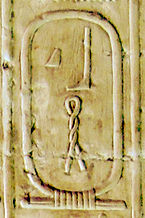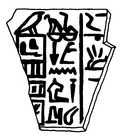| Qa'a | ||||||||||||||||||||||||||||||||||||||||||||||||||||||||||
|---|---|---|---|---|---|---|---|---|---|---|---|---|---|---|---|---|---|---|---|---|---|---|---|---|---|---|---|---|---|---|---|---|---|---|---|---|---|---|---|---|---|---|---|---|---|---|---|---|---|---|---|---|---|---|---|---|---|---|
| Biénechês, Óubiênthis, Víbenthis | ||||||||||||||||||||||||||||||||||||||||||||||||||||||||||
 Restored tomb stele of Qa'a at the Museum of Archeology and Anthropology at the University of Pennsylvania, Philadelphia Restored tomb stele of Qa'a at the Museum of Archeology and Anthropology at the University of Pennsylvania, Philadelphia | ||||||||||||||||||||||||||||||||||||||||||||||||||||||||||
| Pharaoh | ||||||||||||||||||||||||||||||||||||||||||||||||||||||||||
| Reign | 33 years, ca. 2910 BC | |||||||||||||||||||||||||||||||||||||||||||||||||||||||||
| Predecessor | Semerkhet | |||||||||||||||||||||||||||||||||||||||||||||||||||||||||
| Successor | Hotepsekhemwy (most likely) or Sneferka, Horus Bird | |||||||||||||||||||||||||||||||||||||||||||||||||||||||||
Royal titulary
| ||||||||||||||||||||||||||||||||||||||||||||||||||||||||||
| Father | Semerkhet (most likely) or Anedjib | |||||||||||||||||||||||||||||||||||||||||||||||||||||||||
| Burial | Tomb Q, Umm el-Qa'ab | |||||||||||||||||||||||||||||||||||||||||||||||||||||||||
| Dynasty | 1st Dynasty | |||||||||||||||||||||||||||||||||||||||||||||||||||||||||
Qa'a (also Qáa or Ka'a) (literal meaning: "his arm is raised") was the last king of the First Dynasty of Egypt. He reigned for 33 years at the end of the 30th century BC.
Identity

Manetho calls Qa'a Biénechês and gives him a reign of 26 years according to the version preserved by Sextus Julius Africanus. Other versions of copies of Manetho's epitomes give other hellenized names such as Óubiênthis for versions by Eusebius and Víbenthis by Armenian versions of Eusebius.
Family
See also: First Dynasty of Egypt family treeThe parents of Qa'a are unknown, but it is thought that either his predecessor Anedjib or Semerkhet was his father, since it was tradition to leave the throne to the eldest son. If Manetho suggested correctly (remembering the tradition), Semerkhet was the father.
Reign
There is not much known about Qa'a's reign, but it seems that he reigned for a long time (around 33 years). Several stone vessel inscriptions mention a second Sed festival for Qa'a, which points to at least 33 years of reign. The first festival was usually not celebrated before 30 years of reign, and subsequent festivals could be repeated every third year. The Palermo Stone only mentions the year of coronation and some usual cultic events that were celebrated under every king. The numerous ivory tags dating to his reign also mention only typical arrangements, such as depicting and counting burial offerings and personal possessions of the king. Several mastaba tombs of high officials date into Qa'a's reign: Merka (S3505), Henuka (burial unknown), Neferef (burial also unknown) and Sabef (buried in the royal necropolis of Qa'a).

End of reign
Despite Qa'a's long and prosperous reign, evidence shows that after his death, a dynastic war between different royal houses began over the newly empty throne. In the tomb of the high official Merka, a stone vessel with the name of a king Sneferka was found. It is unclear whether "Sneferka" was an alternate name of Qa'a or if he was a separate, ephemeral ruler. Egyptologists such as Wolfgang Helck and Toby Wilkinson point to a further mysterious ruler named "Horus Bird", whose name was found on vessel fragments dating to the end of the first dynasty. It is postulated that Sneferka and Horus Bird fought for power and that Hotepsekhemwy ended the fight and finally ascended the throne of Egypt, thus starting the Second Dynasty. Strong clues to that theory are traces of grave robberies and arsons found in the royal tombs of Abydos. Clay seals of Hotepsekhemwy found in Qa'a's tomb suggest that he restored the tomb or buried Qa'a, maybe in an attempt to legitimize his rule.
Attestations from tombs

Qa'a had a fairly large tomb in Abydos which measures 98.5 X 75.5 feet or 30 X 23 meters. A long reign is supported by the large size of this ruler's burial site at Abydos. This tomb was excavated by German archaeologists in 1993 and proved to contain 26 satellite (i.e. sacrificial) burials. A seal impression bearing Hotepsekhemwy's name was found near the entrance of the tomb of Qa'a (Tomb Q) by the German Archaeological Institute in the mid-1990s. The discovery of the seal impression has been interpreted as evidence that Qa'a was buried, and therefore succeeded, by Hotepsekhemwy, the founder of the second dynasty of Egypt, as Manetho states. The beautiful tomb stela of Qa'a is now on display at the University of Pennsylvania Museum of Archaeology and Anthropology.
The tomb of one of Qa'a's state officials at Saqqara—a certain nobleman named Merka—contained a stele with many titles. There is a second Sed festival attested. This fact plus the high quality of a number of royal steles depicting the king implies that Qa'a's reign was a fairly stable and prosperous period of time.
A number of year labels have also been discovered dating to his reign at the First Dynasty burial site of Umm el-Qa'ab in Abydos. Qa'a is believed to have ruled Egypt around 2916 BCE. A dish inscribed with the name and titles of Qa'a was discovered in the tomb of second dynasty pharaoh Seth-Peribsen (Tomb P of Petrie).
See also
References
- "Qa'a | Ancient Egypt Online".
- ^ "LacusCurtius • Manetho's History of Egypt — Book I".
- Peter Clayton: Chronicle of the Pharaohs. Thames & Hudson Ltd, 1994. p.25
- ^ Wolfgang Helck: Untersuchungen zur Thinitenzeit. In: Ägyptologische Abhandlungen Band 35, Harrassowitz, Wiesbaden 1987, ISBN 3-447-02677-4, page 124.
- P. Lacau, J. P. Lauer: La Pyramide a Degeres IV, Inscriptions Gravees sur les Vases. Cairo 1959, page 12.
- ^ Toby A. H. Wilkinson: Early Dynastic Egypt. Routledge, London/ New York 1999, ISBN 0-415-18633-1, page 81–83.
- Peter Clayton, Chronicle of the Pharaohs, Thames & Hudson Ltd, 2006 paperback p.25; the tomb is now fully published: Eva-Maria Engel: Das Grab des Qa'a: Architektur und Inventar, Wiesbaden 2017 ISBN 978-3447108768
- G. Dreyer et al., MDAIK 52,1996, pp.71-72, fig. 25, pl. 14a
- B. Porter and R.L.B. Moss. Topographical Bibliography of Ancient Egyptian Hieroglyphic Texts, Reliefs, and Paintings, V. Upper Egypt: Sites. Oxford, 1937, pg 81
| Preceded bySemerkhet | Pharaoh of Egypt | Succeeded bySneferka |
| First Dynasty of Ancient Egypt | ||
|---|---|---|
| Pharaohs |  | |
| Regents | ||
| Queen consorts | ||
| Officials | ||
| Other people | ||
| Artefacts and monuments | ||
| Capital | ||
